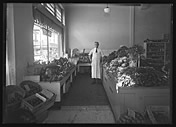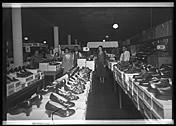|
Excerpted from Sybil Miller, Itinerant Photographer: Corpus Christi, 1934, Albuquerque: University of New Mexico Press, 1987. Reproduced with permission. Page numbers of the original text are noted.
IN EARLY 1934, CORPUS CHRISTI, TEXAS, was a fairly active small city, prosperous and optimistic compared to communities hit harder by the Great Depression. [That year] a transient came to town, just as transients drift to the south Texas coast every winter, but this man was different. He carried a camera, wore a suit, and asked for no hand-outs... The Corpus Christi photographer was simply a working man who carried his trade with him and lived on the fringes of society while photographing doctors, lawyers, judges, and those with less prestigious occupations...
During the Depression even successful studio photographers found themselves in financial trouble, and itinerant photographers, like their contemporaries the Bibles salesmen, knew that their livelihood depended on surefire sales techniques. Itinerant photographers were often called "kidnappers," a term that originally applied to door-to-door baby photographers. Making his way through a residential area, leading a pony, the kidnapper would introduce himself to the housewife, flash a few prints he had made of other children, and declare that he wanted to photograph the woman's children—no charge, no obligation. A few days later, the kidnapper returned offering the image he had made for "ransom." Parental pride usually ensured a sale. Eventually the term "kidnapper" came to be applied to all photographers with this calculated sales approach, including some who photographed passersby on street corners and specialists who made the rounds of shops and businesses, like the Corpus Christi photographer. While to us today the word may seem quaint, in the 1930s kidnapper was a derogatory term used by studio photographers aiming to discredit itinerants, their greatest competition. (p. xi)
Itinerant photographers did not take up a profession so much as they chose a life-style, and many photographers used the camera as a means to travel, escape a boring job, and seek adventure. In the 1920s, the itinerant postcard photographer Paul Holt found the marriage of photography and the road so perfect that he was moved to write a how-to book for other dissatisfied souls, $50 a Week with Camera and Car (1926). In this little guide Holt candidly states his desire for freedom: "All of us have a longing to be gypsies at times, to break away from our bondage to mere things, to leave our prisons of brick and brownstone fronts, and to face the World of Adventure as Free Men." i ...
The lure of independence—both financial and personal—was used to attract young people to itinerant photography in these 1910s and 1920s. A 1913 ad for the Mandel Post Card Machine told the reader to "get out of the 'time clock' line and the 'pay-envelope' brigade. Be a one-minute photographer." ii That same year an ad for the Champion Minute Photo Machine claimed its users could make thirty dollars in the first day. "Be your own boss," with the "easiest, quickest, biggest money-maker known," the Champion's ad read, and successful photographers attested to the camera's money-making ability. It could produce a finished photograph in thirty seconds, two hundred photos in an hour. iii (pp. 2-3) 
1 / 2
(i) Paul Glenn Holt, $50 a Week with Camera and Car, Boston: R. Snyder, 1926, p. 3.
(ii) George Gilbert, ed., Photo Advertisements A-Z, Riverdale, New York: Yesterday's Cameras, 1970, p. 30.
(iii) Ibid.
| | | |

Biel's Self-Service Grocery

Edison Dry Goods

Constable's Office

Union Central Life Insurance

Unidentified auto and marine shop
|